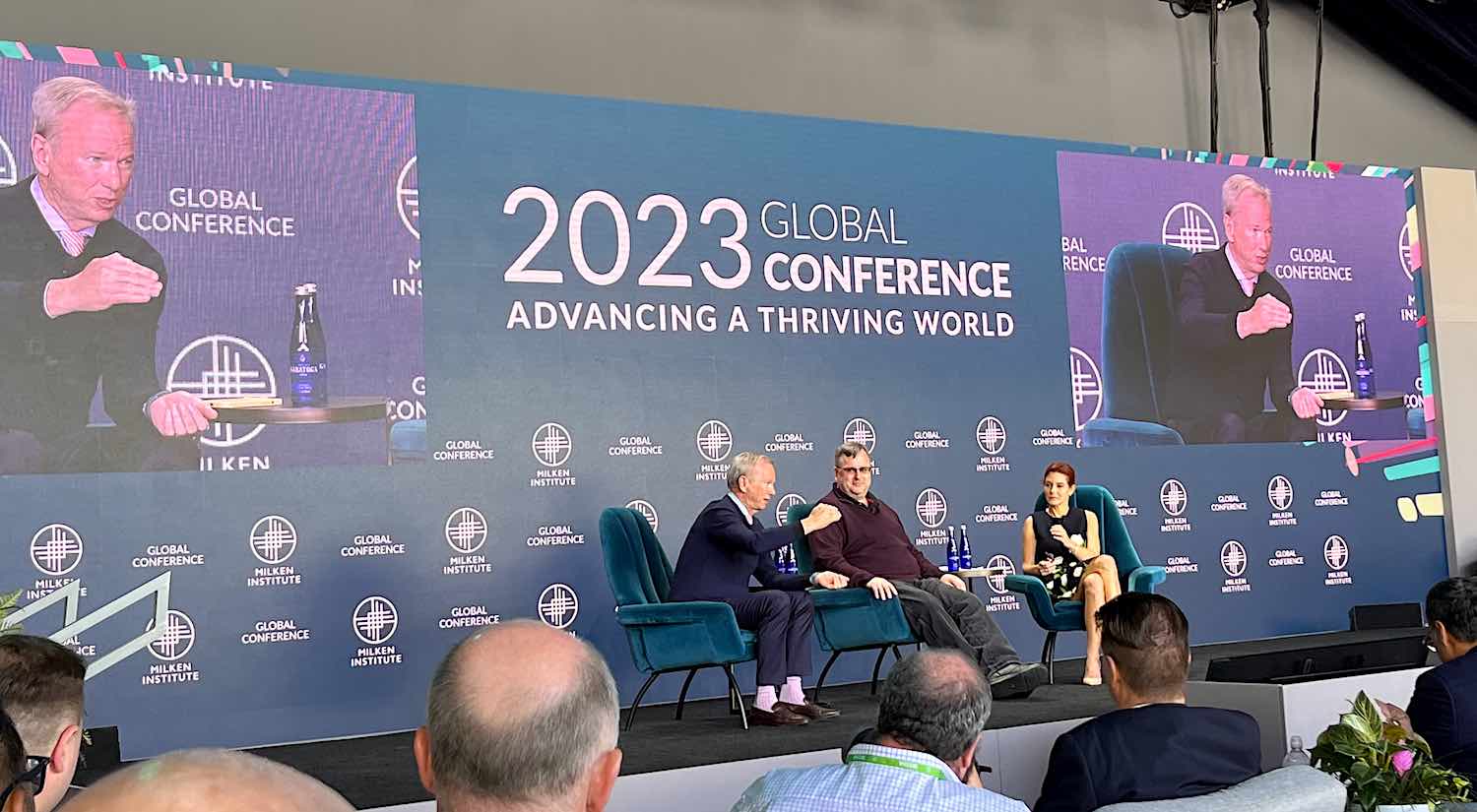Editor’s note: This blog is part of ImpactAlpha’s series, “Sustaining Impact,” authored by participants in the Catalytic Capital Consortium (C3) Sustaining Learning Labs. Key insights have been published in a C3 Guidance Note (for more, see the executive summary and full report). C3 sponsors ImpactAlpha’s catalytic capital coverage.
Back in 2021, we were approached by Laurie Spengler of Courageous Capital Advisors in regards to the Learning Labs that they would be running to support the Catalytic Capital Consortium (C3). Laurie explained that there would be a series of groups convened around the succession of three catalytic modalities – seeding, scaling, and sustaining – as defined by Tideline’s 2019 report on Catalytic Capital. Politely mindful of our time, Laurie asked if Ceniarth would be interested in participating in one of the groups.
We, of course, were enthusiastic about the opportunity. The C3 initiative, championed by the MacArthur Foundation, Omidyar Network, and The Rockefeller Foundation, has been a true bright spot in the impact sector over the past two years.
While much of the sector continues to embrace the hype of “mainstreaming” impact, there are many of us still quizzically scratching our heads wondering when, if ever, some portion of those declared trillions of impact dollars will ever reach communities in real need. Consequently, these C3 Learning Labs would be a genuine gathering of our tribe, a pragmatic forum of practitioners who are actively deploying impact-first capital and seeking ways to catalyze more.
When it came time, however, to pick a specific Learning Lab, we were stymied. Given our flexibility as a private family office and foundation, we are users of all three types of catalytic modalities. We knew it would be a meaningful time commitment, but we could not choose. “We’ll do better than participating in one of them,” we told Laurie. “We’ll join all three.”
For the past year, my colleague Harry Davies and I have joined all three Learning Lab cohorts related to the seeding, scaling and sustaining roles of catalytic capital. We provided feedback to the accompanying Guidance Notes that reflect those conversations, and learned from our peers’ reflections.
In parallel, we have also kept watch on our ultimate “Learning Lab”: how Ceniarth’s own capital was flowing. In 2022, we made nearly $70 million in new capital commitments across nearly 40 transactions. Interestingly, this capital was well distributed across the catalytic continuum: Seeding ($23.5 million), Scaling ($26.7 million), and Sustaining ($19.1 million).
These commitments have been a practical reality check on many of the key themes that we have discussed over the course of the Learning Labs process. In trying to summarize a full year of cohort learnings and our own observed investment behavior, we have arrived at three key observations.
No. 1: Seeding capital means unavoidably dialing up risk
Funding anything new – new enterprises, new managers, new business models – comes with inherent, untested risk. While there are blended capital ways to engage in Seeding transactions that mitigate the risk of some participants, everyone involved is taking some leap of faith.
As our peer Yasmin Saltuk Lamy from British International Investment (BII) wrote last year in regards to her firm’s Catalyst Portfolio, “achieving enhanced development impact requires a more flexible risk appetite because of high uncertainty operating in new sectors or geographies, first-mover disadvantages in pioneering new business models, or higher structural costs that can come from maintaining affordability or reaching the last mile.”
As would be expected, the majority of our Seeding transactions, $14.6 million of $23.5 million, came in the form of higher risk Program Related Investments (PRIs) from our Foundation entity. These included new loans and renewals directly to earlier stage social enterprises such as Farmerline, Kuli Kuli, iProcure, Kasha, and Good Nature Agro, as well as investments in a wide variety of new fund vehicles such as Missio Invest, Spark+ Africa Fund, and the Working Power Impact Fund.
In some of these cases, we are benefitting from subordinate equity or debt provided by others, and in some of the cases, we are the ones taking that risk. Regardless of where one sits in these pioneering transactions, risk needs to be embraced. Much like our colleagues at the Grove Foundation, the DFC, or BII, we cannot deploy all of our capital in this manner, but we can make an explicit carveout to ensure that we are actively participating in these critical deals.
No. 2: Scaling capital means faster, more efficient decision-making
One of the key themes of the Learning Labs process was investee frustration with the opacity, ambiguity, and general head-scratching complexity of investor diligence processes. The work stressed the need for investors to more efficiently collaborate, to adapt diligence to the context of particular funds and entrepreneurs, and to communicate clearly around deal terms and must-haves in the negotiating process. All of these are sensible recommendations worth implementing. They do not, however, allow us to escape the basic fact that hard deals are hard and are going to result in waffling even from the most experienced investors. We, at Ceniarth, are not exempt from this indictment.
In reviewing our deal flow from the past year, we can see a bright spot, however, that as funds and enterprises move from seeding to scaling, diligence processes, at least for us, become significantly more streamlined. Collaboration improves as our confidence in advocating for these funds and enterprises with our co-investors increases. Concerns can be mitigated by trust built through an existing relationship and the experience of watching management handle previous challenges.
For example, Cross Boundary Energy has been a longtime Ceniarth partner from its earliest days. We have seen them through the seeding stage to a point where they are now scaling and accessing capital from major private equity and pension funds for their renewable energy development projects. Even so, bespoke financing gaps emerged in 2022 that we were able to support deploying over $6 million to the firm in shorter term facilities.
We similarly increased our commitments to long-time partners such as Community Investment Management (CIM), Elevar Equity, and Lendable. While, for many of these firms, participation from catalytic investors will account for a smaller fraction of capital raised over time, our continued engagement remains an important practical and symbolic anchor to these firm’s impact alignment.
No. 3: Sustaining capital requires persistence and patience
In the fairy tale version of catalytic capital, the gap that our money fills is transient. Through the stormy days of seeding and the ups and downs of scaling, we walk hand in hand with our fund partners into the sunny, bountiful fields of mainstream capital seeking impact results across asset classes and geographies. Here, on our mythical mountain summit, commercial capital flows from towering waterfalls quenching the years long thirst for adequate capital. While we wish this cinematic vision of Eden existed, it is rare that we have seen it in practice.
Yes, there are certain private, impact fund managers that will cross the chasm as track records extend and assets under management (AUM) grow. But, for many, there is no unlimited, commercial money spigot to be tapped. Gaps and opportunities are not transient, but rather structural and will almost always rely on catalytic investors willing to stick with these interventions. These deals tend to center on sectors and geographies that have persistently lower returns or higher perceived risks and thus are deemed “uninvestable” by pure commercial investors and even by many mainstream impact investors.
In 2022, we provided significant amounts of capital to these types of Sustaining deals. The U.S. Community Development Financial Institution (CDFI) market is a classic example of a sector that has been successful for decades operating in areas of persistent poverty, but that can only do so through the continued support of catalytic investors delivering patient, modest-return seeking capital. During the year, we helped anchor a new intermediary, the Black Vision Fund, that provides lending capital to established CDFIs with an emphasis on serving more minority entrepreneurs.
Similarly, many specialized, impact-first microfinance lenders require catalytic investors willing to be flexible partners. In December, we were approached by our existing, high impact fund partner MCE Social Capital about a short-term capital gap. While MCE has a long history and track record relative to others in the market, they are still reliant on donors and catalytic investors to sustain their model. As an existing lender to MCE and an engaged thought partner on their impact initiatives, we processed a $3 million loan to them within 72 hours of identifying the need.
We also increased fund commitments to existing microfinance investment vehicle (MIV) relationships such as IIX’s Women’s Livelihood Bond Series and MicroVest, as well as participating in direct, co-investment deals with Global Partnerships, another shining illustration of a non-profit impact manager that has successfully blended both grant support and catalytic investment to build a thriving firm.
Toward greater collaboration
We are proud of the work produced by the Learning Labs and, in many ways, we are sad to see them conclude. They were a regular date on our calendar to log into Zoom and see the friendly faces of our real peers: foundations, family offices, and development institutions that embody the original spirit of the impact investing field.
The C3 initiative has been a powerful force in distinguishing the very different realities and challenges faced by those of us living in the impact-first corner of the sector’s big tent. We are hopeful that while these sessions may have concluded that they will be a catalyst for continued collaboration, cooperation, and, at times, commiseration amongst those of us pushing this field toward even greater impact.
Greg Neichin is managing director at Ceniarth LLC




